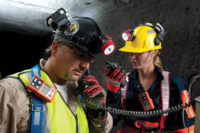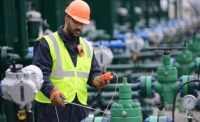Use this checklist for PPE and gas detection

In the past year and a half, more than 20 weather and climate disasters, each with losses exceeding $1 billion, occurred in the U.S. and Canada. Consisting of 11 severe storms, four floods, a drought, regional wildfires, and a winter storm, these events caused 185 deaths.1
Recovery efforts present dangers that include carbon monoxide poisoning, musculoskeletal hazards, heavy equipment accidents, extreme heat and cold, unstable structures, hazardous materials, fire, confined spaces, worker fatigue and respiratory hazards.2
While virtually every worksite requires the use of personal protective equipment (PPE) and gas monitoring instrumentation, the added and varied risks of disaster cleanup efforts demand special attention. The following Top 10 Checklist of Health & Safety PPE for Disaster Cleanup Workers outlines many of the unique considerations involved.
1 Gas monitoring
Gas monitoring devices alert workers to the availability of sufficient oxygen (O2) as well as the presence of dangerous combustibles (lower explosive limits or LELs) and toxic gases such as carbon monoxide (CO), hydrogen sulfide (H2S) and hydrogen cyanide (HCN).
Portable gas detectors can be used on-site, in confined spaces, and when performing spot leak testing. Single-gas detectors offer low-cost protection and reliability. Multi-gas detectors offer added features and protection. A fleet of detectors can be managed with the use of docking/charging stations. An area-wide wireless gas monitoring solution can be rapidly deployed, using a command and control center to collect and transmit data from wireless multi-sensor monitors worn by workers or installed along the perimeter of the defined area.
2 Head protection
Entering a damaged structure presents workers with many overhead dangers, including flying or falling objects, power lines, accidents from equipment or tools and similar hazards. Hard hat impact protection is divided into two categories. Type I hard hats are designed to reduce the force of impact from a blow to the top of the head. Type II hard hats are designed to reduce the effect of lateral force exerted on the head.
Lightweight, high-impact materials and a snug and comfortable fit are essential. A good-quality suspension (the support frame) is important. The more suspension points, the greater the comfort — and the more energy from an impact that can be attenuated, or spread over the hat.
Where applicable, consider compatibility with other PPE and accessories such as liners, face shields and hearing protection.
3 Eye and face protection
Sealed eyewear is ideal for protection in dirty environments. Extended wraparound frames increase protection and peripheral vision. Flexible widths, an adjustable nose bridge, and ratcheting temple hinges allow customization of fit and comfort. Anti-fog lenses help preserve vision where exertion, heat and humidity exist.
Full-face visors offer increased protection where tasks such as steel cutting and concrete sawing can generate flying particles or hot liquid droplets.
4 Respiratory protection
Gases, toxic chemicals and carcinogens, fumes and particles can linger during cleanup, refurbishment and reconstruction. Respiratory hazards include asbestos and silica. Employing single use, reusable face masks; half-face or full-face respirators; or ventilated hoods help prevent dust inhalation.
5 Hearing protection
Effective hearing protection reduces the level of sound exposure to permissible limits while allowing users to maintain real-time personal communication and situational awareness for their efficiency and safety. When selecting protection, consider noise exposure and desired protection levels, product type (earplug or earmuff), style (single/multiple-use, banded, etc.), and other product features (size, corded, sound management, etc.). Training and testing help users ensure proper fit and protection.
6 Protective clothing
Full-coverage, single-use/disposable coveralls protect against extensive dirt and grime. Worker efficiency, flexibility and comfort are enhanced with proper sizing and features such as vents; knitted cuffs; elastic at the ankles, hood, and waist; and a storm flap. If fire is a risk, specify coveralls rated as flame-retardant or fire-resistant.
7 Hand protection
Achieve a required cut level by using fiber technologies or blends of cut-resistant fibers with stainless steel or glass fibers. Coating polymers provide protection in different degrees. A chemical resistance chart can help with specifications. If permeation and degradation information is not provided, contact the manufacturer.
Comfort, dexterity, grip and breathability are important attributes. Wrong-sized, uncomfortable or inappropriate gloves may be discarded by the wearer — along with their intended protection. Match gloves to cleanup hazards.
8 Foot protection
Potential foot injuries include impact, crush, puncture or slipping injuries. Safety footwear should feature a protective toe cap, steel midsole, and ankle protection to protect from falling debris or punctures; enhanced slip resistance on the sole; a self-cleaning tread; and high flexibility and durability. Uppers should be made of breathable water-resistant material. Comfortable footwear helps prevent wearer fatigue.
9 Fall protection
If possible, avoid work at height; many accidents occur even at low levels where fall dangers have not been considered. Specify personal fall protection equipment (PFPE) to reduce the potential of falling (restraint) and to reduce the effects of a fall (fall arrest). Consider the user, environment and application. Require proper training, inspections and equipment maintenance. Ensure that a rescue plan and qualified individuals are in place.
10 Electrical safety
Even though electrical equipment is turned off, it can become temporarily re-energized (for example, during an electrical storm). Qualified workers in close proximity to energized equipment or downed power lines must wear arc flash protective clothing, rubber insulating gloves, hard hats, and face shields. National safety standards require the training of employees regarding selection, use, and maintenance of their electrical PPE. Dielectric boots and overshoes protect against step potential.
To meet cleanup threats, proper selection of PPE, gas monitoring scheme and culture of safety must all be in place, with intelligent design.
Reference:
1 “Billion-Dollar Weather and Climate Disasters: Overview,” The National Centers for Environmental Information (NCEI), https://www.ncdc.noaa.gov/billions/overview
2 “Worker Safety During Fire Cleanup,” Centers for Disease Control and Prevention (CDC), http://www.cdc.gov/disasters/wildfires/cleanupworkers.html
Looking for a reprint of this article?
From high-res PDFs to custom plaques, order your copy today!





